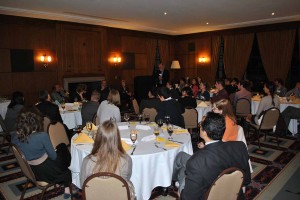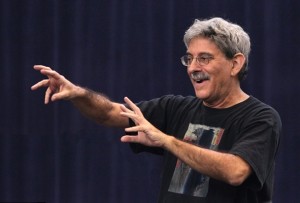Artist Spotlight: Theater maker Rob Drummond
Editor’s note: Theater maker Rob Drummond’s Bullet Catch was part of UMS’s 2014-15 season. He returned this season for an extended educational residency, a collaborative effort between the University of Michigan’s Medical Arts program and UMS’s educational programs at U-M. As part of the residency, Rob is researching for a new play related to medicine. We asked him to write about his adventures in Ann Arbor.
November 6
I left the flat this morning at 4:30 am. I have not slept. And now the border control guy is doing his job. That’s all he’s doing. His job. Don’t blame him. Don’t get angry. That will only make things worse. I’m sitting in ‘the room.’ I’ve seen other people brought here but they were (borderline racism alert) not white, middle class, English speaking Brits like me. There’s an Asian woman sitting near me who looks on the brink of tears. As people in ‘the room’ often look. As I most likely look. I have tried to explain what I am doing over here.
Well, one thing I’m doing is running theater workshops for medical students.
The border control guy stares at me for around five seconds, like a dog trying to lip-read. And then replies …
Why?
Hmmm. How to explain my practice of cross-disciplinary, immersive artwork in one ‘get you across the border safely’ soundbite. Apparently, it can’t be done. So now I’m in ‘the room.’ And he’s on the phone to Mary Roeder, UMS Manager of Community Engagement, whose number I have got from the laptop that currently has 6% battery left. The laptop that has all the information about my stay here on it. And my adapter is in my suitcase. If that battery dies, then so do I. A bone-fide ticking clock drama on my hands here.
The longest three minutes of my life pass by before Mary calls back. She seemed to say the right things, and before I know it Officer Crocker was escorting me out of ‘the room’ and back into the airport. I hate Officer Crocker. Not because he was just doing his job. But because he did it with such grim authority. He is everything, I think, that the arts are not. He is the reason I make art. The world needs less of him.
November 7
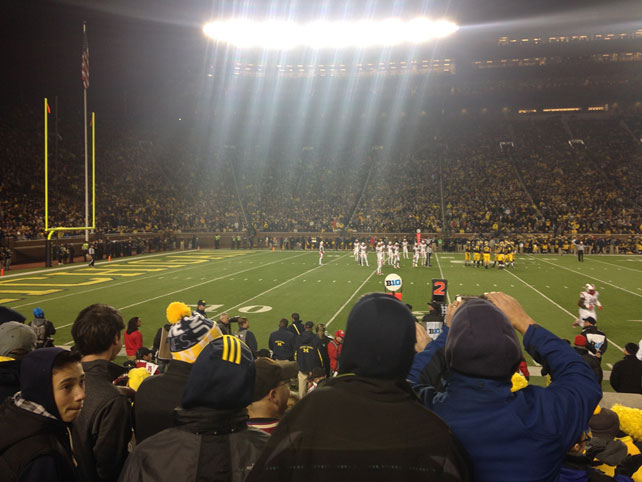
If America were a person, I’d recommend psychiatric help. This was my first thought upon walking into the stadium where one hundred and eight thousand people had gathered to watch college kids playing football. Pure theater. My second thought. I used to play rugby at a decent level for my college. I remember the time we had forty people show up to a game and spoke of it for years to come. Everything is bigger in America.
November 9
I got a look at the Kevorkian papers today. Incredible collection, and something I would not have been able to access without this residency. I didn’t realize Kevorkian was an artist as well as a doctor. As well as a murderer. But was he? Or did he just help desperate people to do something they couldn’t do themselves? His name is certainly whispered as that of some sort of a boogie-man figure, but reading through the letters of his patients, I couldn’t help but feel that he was doing some important work in a controversial way. He was certainly challenging the status quo. Challenging conventional notions of morality. And he certainly had confidence in his convictions. I couldn’t help but like him. But maybe I am romanticizing him. Much much more research is required before I can begin work on anything that is even remotely like Kevorkian, the Musical, as my fevered imagination had already titled the project I had, before today, never even considered working on.
In the afternoon I visit a patient presentation class, which plays out remarkably like a play. We are introduced to the main character, a real life patient, who reminds me slightly of Woody Allen, and then we are invited to re-visit his experience in being diagnosed with a mystery illness. I am trying my best to guess along with the students (incredibly intelligent, all) and, thanks to many many hours of watching medical dramas, I manage (in my head, I don’t dare raise my hand) to follow the case and even make some sensible assumptions. I am struck with an idea that I must speak to Joel Howell (U-M Professor ad doctor) about. Replacing an hour of lectures every term with a play which explores the medical and ethical dilemmas of a specific patient’s case. Sort of like this but more highly dramatized, using actors and performed in a theater (not that type). I need to stop having ideas for things I am not here specifically to work on.
In the evening my mind turns fully to the reason I am here. Interviewing medical students and doctors about their experiences. I am writing a play for the Royal Court Theatre in London, and I think Act Two will be a verbatim piece using the testimonies of said medics and, more specifically, the topic if delivering bad news. It fascinates me as a dramatist that these people spend so much time surrounded by death and yet seem so well-adjusted. Perhaps it is precisely because they spend so much time in and around the thing that the rest of us try to avoid that makes them so well-adjusted. Or perhaps they are not as well-adjusted as I think. As the interviews commence, I realize that it is a combination of the two. It also strikes me that perhaps medical students are the only group of people who think about death as much as artists do.
November 10
What I was finding hard to explain to Officer Crocker is that when I make a piece of theater, I often like to immerse myself in the world so that I can feel more authoritative when I write about it. I have trained as a magician (the show which originally brought me to Ann Arbor and started this whole crazy love affair), a wrestler, and a dancer for shows in the past, and now was the time to experience just a fraction of what medical students and doctors experience by accompanying Dr. Scally on trauma rounds.
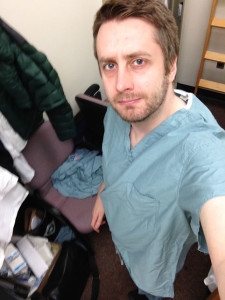
I get up at half-past ridiculous and make my way to the hospital. Which is like a small city. Feeling deeply intimidated and scared, I change into a set of scrubs. You can probably see in the photo below the mixture of fear and tired I was experiencing at this point. And then, as if I had always been a part of the team, as if it was the most natural thing in the world, I accompany two doctors, a resident, and a student (I think I’ve got that right) on rounds. Confidentiality precludes my mentioning anything specific but suffice to say it was an eye opening experience, my major take away being the feeling that doctors absolutely have to develop a dark sense of humor to get them through the day. They have to.
November 12
I have done a few workshops by this point and something that has struck me is that there really is little difference between the artists and the medical students. Whether it be improvisation, writing, or performing, they all enter into it with the same vigor. Both groups offer up insightful and interesting suggestions. Both are equally uncomfortable standing silently in front of the rest of the group. All the workshops are more or less effortless to deliver because the students are so…bright. One group came up with a brilliant play that was set at the top of the Empire State Building during its construction. Four workers on a metal beam, as in that famous photograph. In one-and-a-half hours together we fleshed out this idea, made it real. When I left, one of the students was sitting and writing in the hall. She said she had started writing the play we had just created. I was pleased. I went out and ate some food. Drank far too much beer (Apparently the Hop Cat loves a British accent). And when I came home again around half eleven…She was still there. Still writing.
It might have been the beer, but that made me choke up a little.
November 16
Really getting to know and like the people who are showing me such great hospitality while I am here. The interviews are going so well — getting so much incredible material. The students and doctors alike are amazingly open, to the extent that I am starting to feel guilty about milking them for their stories of misery. However, what has been coming out of this is the understanding that they are anything but miserable despite the fact they are surrounded by so much of it. They are doing a good thing with their lives. The delivery of bad information is not enjoyable, but the fact that they take part in such vital conversations, perhaps the most vital you will ever have, fills many of them with a kind of satisfaction. It’s a privilege. That’s a phrase I’m hearing a lot. It’s a privilege to be trusted with such a sensitive moment in a person’s life. To be sharing something real. Again, a massive similarity between artists and doctors presents itself. We are both looking for something real. We are both searching for truth. In many different ways.
November 17
I had a rip-roaring time at a trivia night last night (the only thing we won was an over-sized Miller Lite T-shirt which my wife is now wearing as a night-gown), but I was a good boy and didn’t drink too much as I knew I had to be up for another set of rounds, this time internal medicine, with Dr. Fine. As the picture below might suggest, this set of rounds did not require me to wear scrubs, so I felt a little less awkward. Again, I was welcomed into the fold as if I was just another medical student. The patients, I realized, didn’t have a clue that I wasn’t some world leading expert in something, which actually made me relax a little bit. Little did they know I was actually a nervous, anxiety ridden, socially awkward wreck. But actually, from the interviews I have conducted, I have come to realize that this is the normal way for a student to feel in a hospital.

These rounds are different. Less immediate danger. But more emotional somehow as the patients stories can be delved into in more detail. I come out feeling my respect for doctors deepen still. Dr. Fine genuinely cares about his patients. He cares not only about making them physically better but making sure they are emotionally cared for.
November 18
Another session with the Kevorkian papers is followed by my last workshop. We seem to save the best for last as together we come up with a concept for a play and create another world in an hour-and-a-half. This is the story of a young offender in prison. The twist is we never see her face. We only hear her voice and we learn about her through the visitors she receives. A really genuinely exciting concept created from nothing and fleshed out with characters, a plot line, and a question we collectively try to answer. What Price Truth? I’ve capitalized that question because it also works as the title. What is the truth worth? Should the girl lie for a reduced sentence or keep telling the truth and get life? Should we tell the difficult truths or lie for an easier life?
This cuts to the heart of the play I am working on for the Court. How do you tell someone they are going to die? Do you sugar coat or do you tell them the cold hard truth? Is it ever right to withhold information from a patient to spare their feelings? What Price Truth?
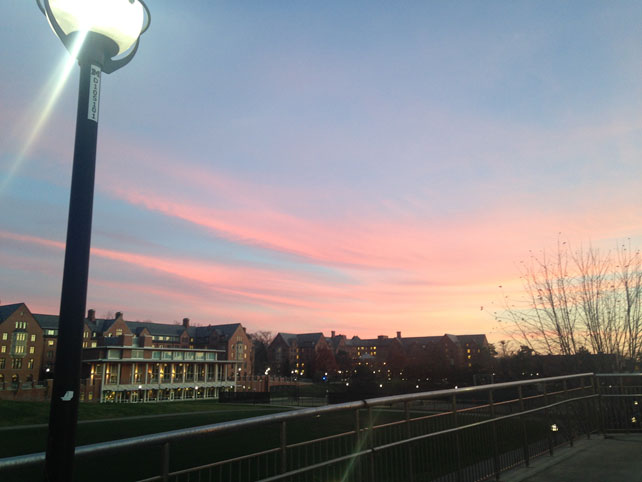
A good way to end my stay.
November 19
I left Michigan yesterday evening. And now I’m going through customs at Glasg-. Oh. I’m through. He barely looked at my passport. The joys of returning to your home country as a national. On my way though, I see a passenger has been taken aside (we don’t have the budget for a whole room apparently) and is being questioned. He doesn’t speak much English – he’s dark-skinned, possibly Indian, I’m not sure. The difference? This time the border control people are smiling. Joking with him. Trying to put him at ease. We’ll get this sorted. Don’t worry.
You see that Officer Crocker. That’s how you do it.
Rob Drummond is a writer, performer and director from Glasgow. His theater credits include Sixteen (Arches Theatre Festival), Hunter (National Theatre of Scotland and Frantic Assembly), Mr Write (Tron Theatre and the National Theatre of Scotland), and Rob Drummond: Wrestling (The Arches, winner of a Vital Spark Award), among others.
UMS and the Medical Arts Program
The fall of 2010 marked the official kick-off to the Medical Arts program, a collaboration between the University of Michigan Medical School and UMS. The goal of Medical Arts is to enhance the ability of medical students and house officers at U-M to deliver high-quality, humanistic clinical care through the immersion and analysis of specifically designed arts experiences, as well as experience in health care for artists.
On the UMHS side, the program is being led by Dr. Joel Howell and Dr. Sanjay Saint. The arts play a significant role in each of their lives, and they know first-hand how powerful it can be in physcian training. During the pilot of this program last year, Dr. Howell and Dr. Saint exposed students to multiple art forms, in addition to the UMS season – from trips to UMMA to book discussions and poetry readings. Both Dr. Howell and Dr. Saint work with visting artists, and UMS’s Director of Education, Claire Rice, to design the artist/medical student interactions that are fun, challenging, and rich in links between the two fields.
The Medical Arts program received a National Creative Campus Innovations grant from the Association of Performing Arts Presenters (APAP) funded in part by the Doris Duke Foundation last summer, based on its highly-successful and oversubscribed pilot-program entitled “Medicine and the Arts.”
Participants in the program will have many opportunities to draw links between their work in the medical field and that of the artists with whom they engage. Benchmarks for project success could include decreases level of self-reported burnout and cynicism, higher levels of professionalism, and a measurable increase in the participants’ awareness and responsiveness to the needs of their patients.
Although the comprehensive evaluation and research component of this project won’t fully kick in until next season, some very unique and engaging experiences have been created for participants in year one. In October, participants shared dinner and discussion with members of the Takàcs Quartet–a conversation that ended up centering around team work.
In November, visiting artist Stephen Nachmanovich led a workshop on improvisation and free play. A workshop highlight was an activity called the “lemon game” where participants were split into two groups of 15. They were then blind-folded, handed a lemon labeled with a number and given time to get to know their assigned lemon. Some people focused on getting to know every indentation and ridge of their lemon, while some focused more broadly on weight or overall shape.
Others spent time getting to know other people’s lemons in order to differentiate their own. The lemons were then collected and placed together in a grocery bag in the center of each group. You can guess what comes next—with their blindfolds off, participants had to find their lemon amongst their group members’ lemons. AND surprisingly enough, the accuracy rate of finding the correct lemon was almost 100% among the two groups of participants. This activity, and others like it, prompted an important conversations about communication–about listening, meditation, and using every sense at your personal disposal.
The feedback from participants in the Medical Arts program this year has been inspiring to say the least. Here are some highlights from the feedback we’ve received:
What connections did you perceive between your experience with Stephen Nachmanovich and your medical world?
“The experience with Stephen Nachmanovich cultivated simple but fundamental insights into how we live our days our humans and how we percieve the world as physcians. I truly see the exercise as a form of meditation, of increased awareness of the present moment. Such meditative awareness I think is invaluable to personal health, maintaining balance in a busy life, and being a physician who is present with and effectively connects with patients.”
What did you enjoy most about your dinner and performance experience with the Takàcs Quartet?
“Being able to talk to the Takács quartet as a group to foster good correlations between the health and arts, and then being able to extend those ideas in a more personal setting as they sat at the table with us. The performance was then even more meaningful as I was constantly reminding myself of the hard work and passion they put into their performance and what beauty came out of it, and how this could be applied to my career.”
We look forward to rounding out the first year with some very special experiences this winter and spring. In total, there will be approximately eight different sessions touching on a variety of different disciplines and art forms.
Upcoming Events:
Next week, program participants will be engaging with legendary director Benjamin Bagby of Sequentia for dinner and discussion. Conversation will focus around how his research into the the music, literature, and thought of the time informs his creative process. During this period, science and the arts were not seen as being as separate as today, and we will discuss with Bagby what links can be drawn between music and medicine.
In February, participants will have the opportunity to engage with members of the Merce Cunningham Dance Company, including a panel on how an artist’s creative process changes over a lifetime and how one’s physical aging process impacts the creative process. These themes will continue over dinner with MCDC Executive Director Trevor Carlson, and conclude with the participants attending the live performance the following night.
We’ll look forward to sharing artist and student feedback, and program developments here in the UMS Lobby!


